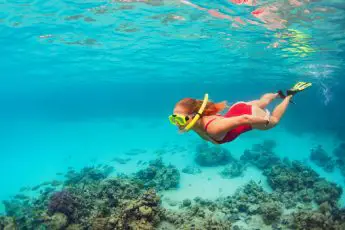Introduction
Quick Navigation
Scuba Diving and Snorkeling are quite similar because they both involve the underwater experience with gear. While the former requires some levels of expertise, the latter is more like a hobby – fun to anyone new or experienced.
Snorkeling requires not too much equipment; the snorkel seems like the only important thing needed. Unfortunately, not every diver knows how a snorkel really works. However, the importance of this article is to describe the working operation of a snorkel and describe the various types available. With this piece of information, your next snorkeling experience should be a lot better and informative.
How Does a Snorkel Work?
A Snorkel is a piece of breathing equipment for safety underwater. It provides the air needed to survive when submerged in water.
Therefore, one of the differences between a scuba diver and a snorkel diver is the depth at which they can go.
Snorkels won’t only help you breathe comfortably but also allow you to work on your diving skills, i.e., if you are an amateur.
Ideally, there are different types of snorkels, depending on their working mechanism. Exploring these types will give you an understanding of how to use them and look out for problems.
Read on how to fit a Snorkel or Scuba Mask here.
What are the Types of Snorkels?
Asides from working mechanisms snorkel different from themselves in quality. There are also those designed for amateur divers and others for professionals. Below is a description of the 3 types of snorkels that exist.
Classic Snorkels
A Classic Snorkel is the oldest form available. It is a traditional J-shaped tube with a mouthpiece – a recommended choice for new snorkelers because of its simplicity and ease of use. Moreover, it doesn’t really come with any discomfort as long as it is attached properly.
Classic snorkels are attached to goggles and mask with a clip or fixture feature. It rests on the side of the head or face with good positioning of the better part out of the water and the other part underwater – it must be kept straight up. Therefore, you will only have to breathe through your mouth with this snorkel.
For safety, you should keep the snorkel in your mouth always. The only demerit with this snorkel is that jaw fatigue is common.
Dry Snorkels
The modern type of snorkel is the Dry Snorkel. It is a much-advanced device for intermediate and professional snorkelers. Over the years, it has become popular in the diving world because of its safe and easy use. This snorkel prevents water from getting into the tube, which is almost what makes it special.
Dry Snorkels have a wide range of features for effective performance; one of them is the unique, attached floatation device at the tip. This device is a one-way valve to prevent a diver or snorkeler from swallowing water or filling the lungs with water accidentally. Indeed, it is safe and enhances an outstanding snorkeling experience.
Originally, dry snorkels had special masks with two-tubed balls to stop the water. However, the modification with a one-way valve made it even better. Additionally, it is light and quite attractive.
Semi-Dry Snorkels
Another type of snorkel, almost similar to the Dry Snorkel, is the Semi-Dry Snorkel. It is somewhat straightforward from the name – water might get into the tube but can be flushed out immediately. Ideally, it helps to keep water out from a snorkeler’s mouth.
This snorkel uses a one-way purge valve to flush water. This valve is a splash guard attached to the top of the tube. Overall, you would have a Semi-Dry Snorkel comprising of a valve, a flexible tube section, and a silicone mouthpiece.
It is a great choice for amateur and professional snorkelers.
What Safety Tips Will Be Useful When Snorkeling?
While snorkeling is fun and relaxing, you need to be careful about using your gear – particularly the snorkel. There are essential safety tips you should be aware of. They include the following:
Watch the Ocean
One of the mistakes newbies make when snorkeling in an ocean is changing course due to ocean waves. You shouldn’t ever turn your back or jump over on these waves because it could be dangerous. The crashing wave could have snorkel compromised.
If you encounter breaking waves, you should dive or duck under them to counter their force.
Don’t Swim Against a Current
Swimming in murky water is not advisable, so an ocean is all you’ve got for the best experience. However, you are not to swim against a current so that you don’t drown or get water into your lungs due to a damaged snorkel.
What you should do is swim diagonally across a current.
Go With First Aid Kit
Even if you are guaranteed safety, you shouldn’t go snorkeling without your first aid kit. It is the next best thing you need after your snorkel. In the kit, you should have peroxide, cigarettes-tobacco, antibiotic ointment, etc. Each of these things will come in useful if you ever experience marine injuries like stings and bites.
Entry & Exit
Snorkeling sometimes shouldn’t be done alone. It is a buddy sport, so having someone along could be significant – for safety, maybe. If you would have to snorkel, you should make sure to enter and exit from a sandy beach area.
Other Safety precautions
Snorkeling is beyond relying on skills and abilities; it involves doing the right thing. One of the most important things to do is ensuring you or your friends don’t take part in it when drunk.
More importantly, it is not safe to snorkel at dawn or dusk.
Conclusion
A Snorkel, amongst other things for snorkeling, is a useful device to prevent you from swallowing water. As long as you understand how important it is, you wouldn’t gamble on your choice of snorkel for your next diving experience. Besides, you also know what to do and whatnot when taking part in this outdoor activity.

